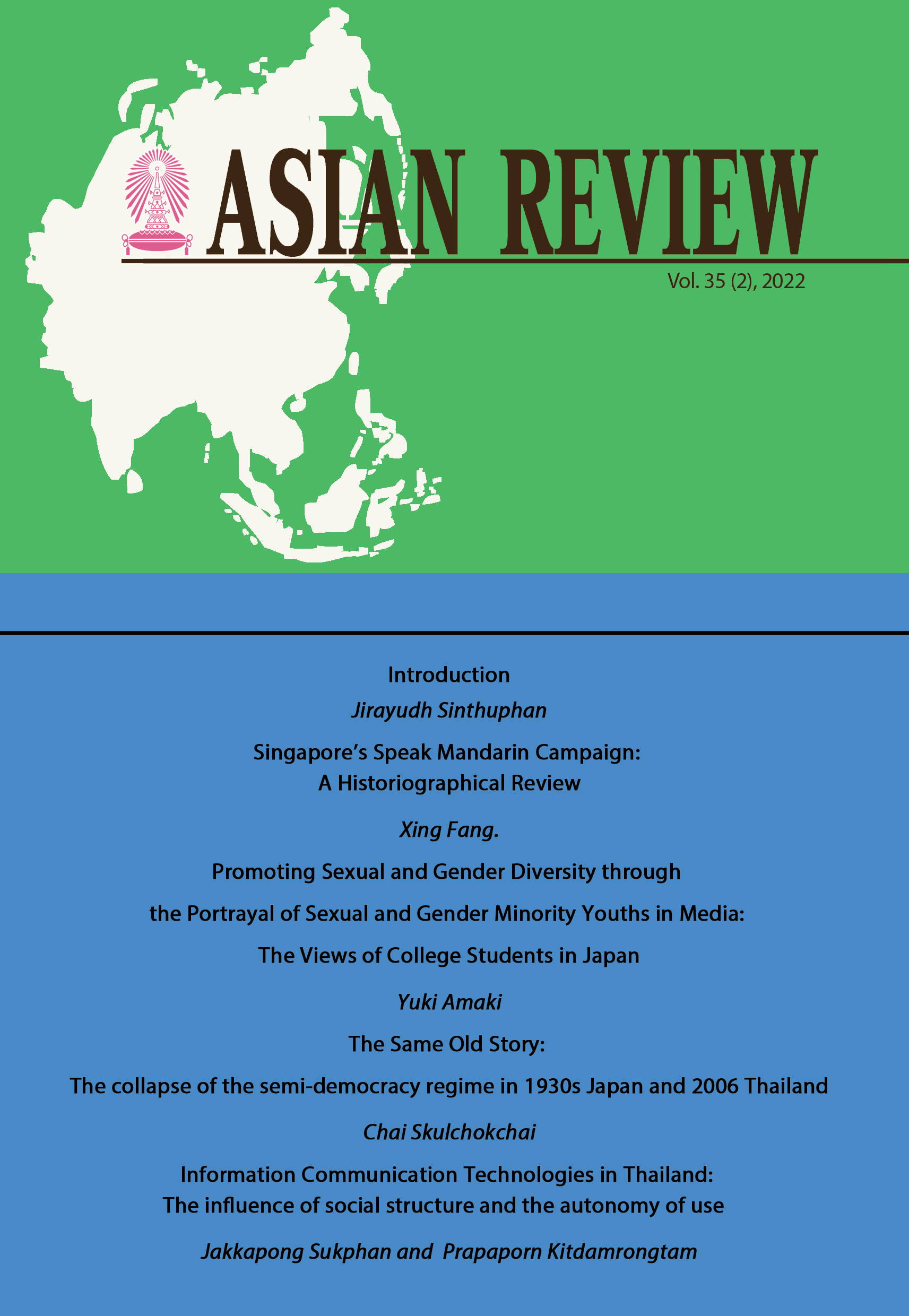Information Communication Technologies in Thailand: the influence of social structure and the autonomy of use
Keywords:
Internet use, Social position, Digital divide, Digital Inequality, Social inequalityAbstract
There has never been digital equality as we face social inequality. This paper aims to examine the uses of information communication technologies (ICTs) and the social structure of the digital divide in Thailand to compare the findings with those reported in more developed countries. Multiple correspondence analysis is conducted to form the scales of internet use and autonomy of use. Linear regressions were used to test the scales' effects on the social structure of ICT use in Thailand.
The findings indicate that Internet use can be categorized into the intensity of internet use and commercial and leisure use. The intensity of internet use is positively related to the autonomy of use and social position indicators. However, social positions are mainly associated with the type of use. This study also emphasizes the influence of the autonomy of use and its social structure on internet use and access. Our research contributes further insights into the social production of the digital gap, particularly in developing countries.
References
Attewell, Paul. 2001. “The First and Second Digital Divides.” Sociology of Education 74 (3): 252–59. https://doi.org/10.2307/2673277.
Brandtzæg, Petter Bae, Jan Heim, and Amela Karahasanović. 2011. “Understanding the New Digital Divide—A Typology of Internet Users in Europe.” International Journal of Human-Computer Studies 69 (3): 123–38. https://doi.org/10.1016/j.ijhcs.2010.11.004.
Bukht, Rumana, and Richard Heeks. 2017. “Defining, Conceptualising and Measuring the Digital Economy.” 68. http://hummedia.manchester.ac.uk/institutes/gdi/publications/workingpapers/di/di_wp68.pdf.
Chakravorti, Bhaskar, Christopher Tunnard, and Ravi Shankar Chaturvedi. 2015. “Where the Digital Economy Is Moving the Fastest.”
Economics. Harvard Business Review. 2015. https://hbr.org/2015/02/where-the-digital-economy-is-moving-the-fastest.
Chen, W, and B Wellman. 2004. “The Global Digital Divide - Within and between Countries.” IT & society, no. 1: 39–45.
Chinn, Menzie D., and Robert W. Fairlie. 2007. “The Determinants of the Global Digital Divide: A Cross-Country Analysis of Computer and Internet Penetration.” Oxford Economic Papers 59 (1): 16–44. https://doi.org/doi.org/10.1093/oep/gp1024.
Deursen, A J A M van, and J A G M van Dijk. 2014. “The Digital Divide Shifts to Differences in Usage.” New Media & Society 16 (3): 507–26. https://doi.org/10.1177/1461444813487959.
Deursen, A J A M van, and E J Helsper. 2018. “Collateral Benefits of Internet Use: Explaining the Diverse Outcomes of Engaging with the Internet.” New Media & Society 20 (7): 2333–51. https://doi.org/10.1177/1461444817715282.
“Digital Na(t)Ives? Variation in Internet Skills and Uses among Members of the ‘Net Generation’*.” 2010.Sociological Inquiry 80 (1): 92–113. https://doi.org/10.1111/j.1475-682X.2009.00317.x.
Dijk, J A G M van. 2005. The Deepening Divide. London: SAGE Publications.
Dimaggio, Paul, Eszter Hargittai, Coral Celeste, and Steven Shafer. 2004. “From Unequal Access to Differentiated Use: A Literature Review and Agenda for Research on Digital Inequality.” In Social Inequality, edited by Kathryn Neckerman, 355–400. New York: Russell Sage Foundation.
Dutton, William H., and Bianca C. Reisdorf. 2019. “Cultural Divides and Digital Inequalities: Attitudes Shaping Internet and Social Media Divides.” Information, Communication & Society 22 (1): 18–38. https://doi.org/doi.org/10.1080/1369118X.2017.1353640.
Gonzales, Amy. 2016. “The Contemporary US Digital Divide: From Initial Access to Technology Maintenance.” Information, Communication & Society 19 (2): 234–48. https://doi.org/10.1080/1369118X.2015.1050438.
Greenacre, M J. 1993. Correspondence Analysis in Practice. London: Academic Press.
Hargittai, Eszter. 2002. “Second-Level Digital Divide: Differences in People’s Online Skills. First Monday.” First Monday 7 (4). https://doi.org/10.5210/fm.v7i4.942.
Hargittai, Eszter, and Amanda Hinnant. 2008. “Digital Inequality: Differences in Young Adults’ Use of the Internet.” Communication Research 35 (5): 602–21. https://doi.org/10.1177/0093650208321782.
Hargittai, Eszter, Anne Marie Piper, and Meredith Ringel Morris. 2019. “From Internet Access to Internet Skills: Digital Inequality among Older Adults.” Universal Access in the Information Society 18 (4): 881–90. https://doi.org/10.1007/s10209-018-0617-5.
Hassani, Sara Nephew. 2006. “Locating Digital Divides at Home, Work, and Everywhere Else.” Poetics 34 (4): 250–72. https://doi.org/10.1016/j.poetic.2006.05.007.
Lee, Sang-Oun, Ahreum Hong, and Junseok Hwang. 2017. “ICT Diffusion as a Determinant of Human Progress.” Information Technology for Development 23 (4): 687–705. https://doi.org/10.1080/02681102.2017.1383874.
Livingstone, Sonia, and E J Helsper. 2007. “Gradations in Digital Inclusion: Children, Young People and the Digital Divide.” New Media & Society 9 (4): 671–96. https://doi.org/10.1177/1461444807080335.
Mascheroni, Giovanna, and Kjartan Ólafsson. 2016. “The Mobile Internet: Access, Use, Opportunities and Divides among European Children.” New Media & Society 18 (8): 1657–79. https://doi.org/10.1177/1461444814567986.
Nipo, Debbra Toria, Imbarine Bujang, and Ting Siew King. 2014. “Global Digital Divide: Determinants of Cross-Country ICT Development with Special Reference to Southeast Asia.” International Journal of Business and Economic Development 2 (3): 83–95.
Ono, Hiroshi, and Madeline Zavodny. 2007. “Digital Inequality: A Five Country Comparison Using Microdata.” Social Science Research 36 (3): 1135–55. https://doi.org/10.1016/j.ssresearch.2006.09.001.
Reisdorf, Bianca C., and Darja Groselj. 2017. “Internet (Non-)Use Types and Motivational Access: Implications for Digital Inequalities Research:” New Media & Society 19 (8): 1157–76. https://doi.org/10.1177/1461444815621539.
Riggins, Frederick, and Sanjeev Dewan. 2005. “The Digital Divide: Current and Future Research Directions.” Journal of the Association for Information Systems 6 (12): 298–337. https://doi.org/10.17705/1jais.00074.
Selwyn, Neil. 2004. “Reconsidering Political and Popular Understandings of the Digital Divide:” New Media & Society 6 (3): 341–62. https://doi.org/10.1177/1461444804042519.
Serrano‐Cinca, C., J. F. Muñoz‐Soro, and I. Brusca. 2018. “A Multivariate Study of Internet Use and the Digital Divide*.” Social Science Quarterly 99 (4): 1409–25. https://doi.org/10.1111/ssqu.12504.
“The Digital Divide”. 2020.Cambridge: Polity Press.
“The First-Level Digital Divide Shifts from Inequalities in Physical Access to Inequalities in Material Access.” 2019.New Media & Society 21 (2): 354–75. https://doi.org/10.1177/1461444818797082.
Tewathia, Nidhi, Anant Kamath, and P. Vigneswara Ilavarasan. 2020. “Social Inequalities, Fundamental Inequities, and Recurring of the Digital Divide: Insights from India.” Technology in Society 61 (May): 101251. https://doi.org/10.1016/j.techsoc.2020.101251.
Wong, Poh-Kam. 2002. “ICT Production and Diffusion in Asia Digital Dividends or Digital Divide?” Information Economics and Policy 14 (2): 167–87. https://doi.org/10.1016/S0167-6245(01)00065-8.
Zillien, N, and Eszter Hargittai. 2009. “Digital Distinction: Status-Specific Types of Internet Usage*.” Social Science Quarterly 90 (2): 274–91. https://doi.org/10.1111/j.1540-6237.2009.00617.x.
Downloads
Published
How to Cite
Issue
Section
License
Copyright (c) 2022 Instiute of Asian Studies, Chulalongkorn University

This work is licensed under a Creative Commons Attribution-NonCommercial-NoDerivatives 4.0 International License.
Published articles are under the copyright of the Instiute of Asian Studies, Chulalongkorn University. Partially or totally publication of an article elsewhere is possible only after the consent from the editors.







